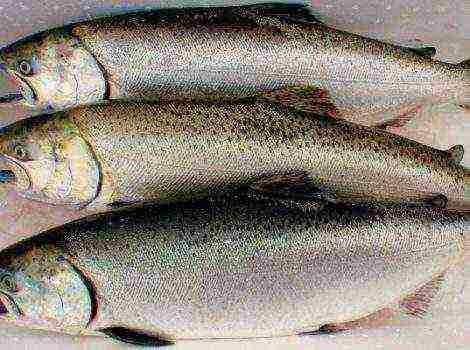Content [show]
Garlic is a hot spice that is actively used in cooking and traditional medicine. Growing and caring for garlic in the open field on their own gives gardeners the opportunity to get the maximum benefit from it without harm to health, which the purchased one can bring. Meanwhile, it is quite easy to grow a culture at home if you know and follow the basic rules of planting and caring for a plant.
Basic rules for growing garlic outdoors
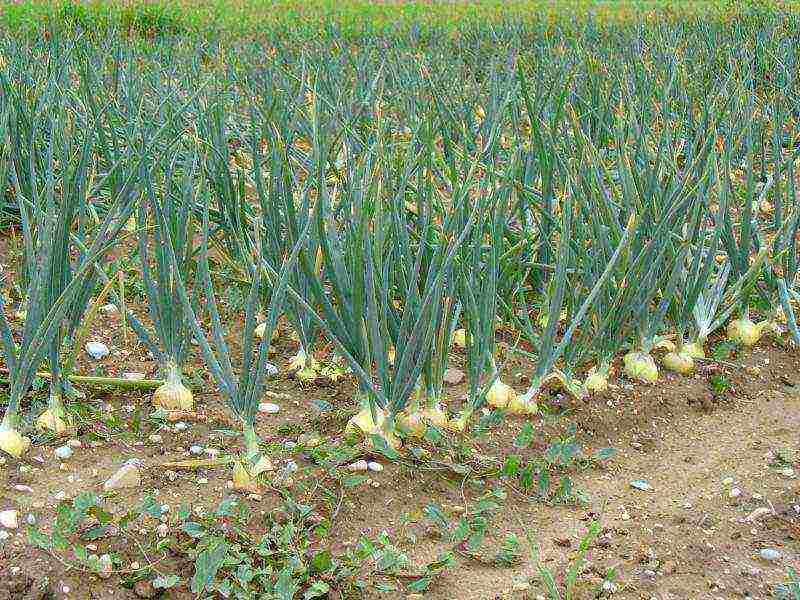
Before starting the growing procedure, it is recommended that you familiarize yourself with the basic rules and recommendations:
- Garlic beds are best chosen in places well-lit by the sun.
- Avoid planting a crop in a low-lying area. In such conditions, the accumulation of liquid is possible, which will have a detrimental effect on the condition of the plants.
- It is important to add natural or synthetic fertilizer to the soil before planting.
- It is recommended to mulch over the winter bed and cover it with brushwood to delay the snow masses.
- The sowing depth directly depends on the size of the seed. The largest varieties should be deepened by eight to nine centimeters, the smaller ones by six to seven.
- Only large seeds should be chosen for planting. Separate them from each other carefully. You do not need to peel the cloves.
- Do not sow into freshly dug soil, otherwise the tines will be deeper than necessary. Prepare the soil no earlier than a week in advance.
- The sowing site should be changed regularly (at least once every two years). You can use the same ridge only with an interval of four years.
The correct approach to growing crops will allow you to grow a high-quality and rich harvest, and also significantly reduce the likelihood of disease and plant death during the nursing period.
When to plant garlic outdoors?
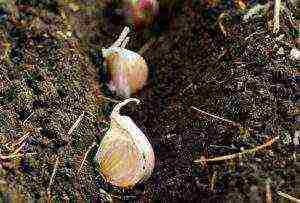 There are two options for planting garlic in open ground: autumn (for winter) and spring (for spring).
There are two options for planting garlic in open ground: autumn (for winter) and spring (for spring).
It is recommended to plant a crop in autumn from the second half of September to mid-October. You can also calculate the timing of the expected frost period, depending on the region.The most suitable time for sowing is 35-45 days before the start.
Spring garlic should be planted when the soil temperature warms up to 5-10 degrees Celsius. As a rule, this time falls on the end of March or the beginning of April.
All sowing dates in spring are relative. In this case, a lot depends on the region. So, in the warmest it is best to plant the crop earlier, in the colder ones - later. The final landing date is the end of April.
Garlic precursors in the beds
The best precursor to garlic is considered to be potatoes. You can also sow a crop in those places where zucchini, cucumbers and peas grew. The worst predecessor is onion of all varieties and varieties. If you grow garlic the next year after the onion is harvested, you can expect a small and poor quality harvest. The same goes for tomatoes and carrots.
The culture can also coexist with raspberry bushes, roses, strawberries, currants. In this case, the plant will help repel pests.
Soil preparation
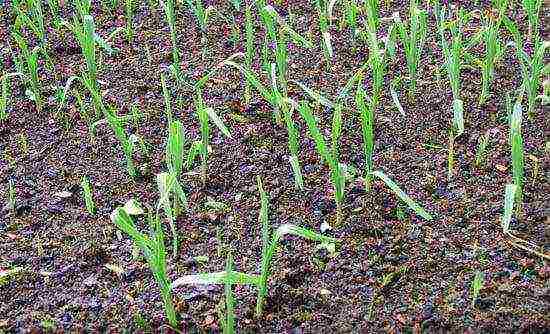
The soil for sowing in open ground should be sufficiently fertile and drained, moisture-consuming. Loam is perfect. It is important that the soil is not dry. The ridge should be prepared for spring sowing in the fall.
To do this, you need to dig up the soil and apply fertilizer to it. For each square meter, you will need twenty grams of potassium salt and superphosphate, as well as a bucket of humus. This procedure can be performed in the spring, no later than two weeks before sowing.
The distance between the finished rows should be d2 decimeters, between other ridges - at least 1. It is best to plant the teeth in the grooves, but at the same time they should not be pressed into the ground. Too dense soil mixture will contribute to the freezing of the plant from the roots.
Important: You can neutralize the increased acidity of the soil with the help of dolomite flour, chalk or hydrated lime.
Preparation of planting material
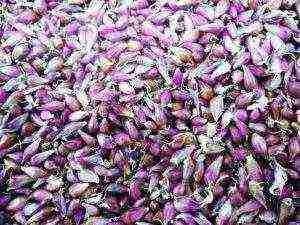 First of all, all potential seed must be sorted out and sorted. Choose for growing only whole, healthy, large seeds. It is them that should be further subjected to pre-planting processing.
First of all, all potential seed must be sorted out and sorted. Choose for growing only whole, healthy, large seeds. It is them that should be further subjected to pre-planting processing.
Important: the presence of at least one tooth damaged by the disease in the head automatically rejects the entire bulb.
The selected seed must be treated with the antifungal agent Fitosporin. To do this, it is enough to soak the cloves in the drug solution for five minutes. In the absence of this remedy, you can use a pink solution of potassium permanganate or 1% iodine solution.
Before direct planting, it is useful to carry out a second processing of the material. To do this, pour half a kilogram of wood ash with a liter of water and boil the composition for half an hour. Each clove will need to be dipped in the cooled solution, and then dried thoroughly.
Sowing is also possible with the so-called bulbs - the organs of vegetative propagation of garlic. These are small bulbs that form in the seed case on the arrow of the plant itself during ripening. The system of material selection, planting and cultivation practically does not differ from the system of using cloves.
Landing in open ground
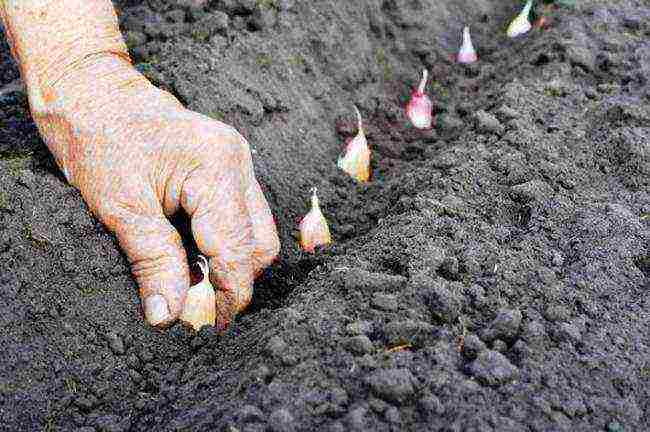
Having prepared the soil and planting material, you can proceed to planting directly.
The procedure will take several steps:
- Loosen the prepared soil with a spatula, hoe or other most convenient tool.
- Make grooves with a depth corresponding to the dimensions of the prepared teeth from five to 10 cm. The distance between them should be twenty to thirty centimeters.
- Place the garlic sprouts down into the grooves, about five centimeters apart. The teeth should be deepened by about half.
- Fill the grooves with soil, trying not to unnecessarily tamp the ridge. Otherwise, the garlic may not sprout.
- Smooth the surface of the ridges with a rake, avoiding deep penetration of the tool into the soil.
The soil for sowing in open ground should be moist, but not wet. Therefore, it is recommended to shed it in advance.
Outdoor garlic care
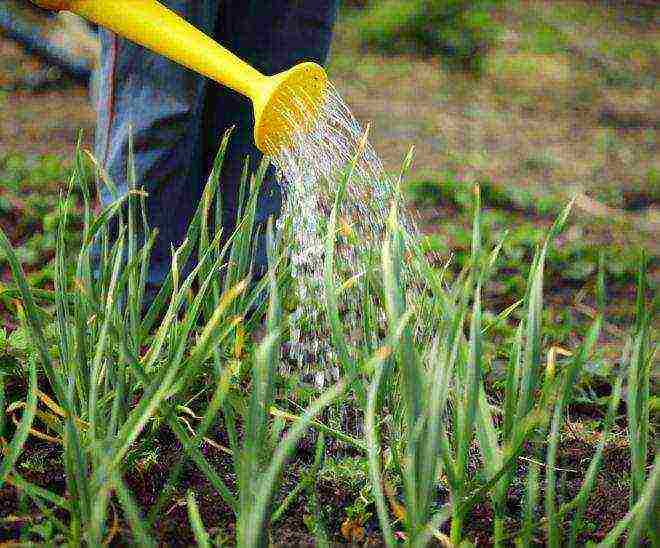
Basic crop care includes four aspects: timely watering, weeding, fertilizing and loosening the soil.
Watering
It is recommended to bring water into open ground regularly, but infrequently (once every one to two weeks). It is enough to use 10 liters of water per square meter. During the rainy season, the number of waterings should be reduced to a minimum. At the same time, it is important to periodically loosen the soil so that it absorbs moisture better.
As the ridges mature, they are watered with less and less moisture. Watering is completely stopped 2 weeks before harvesting.
Fertilization and pest control
1 time in 10 days, it is necessary to add potash and phosphorus additional fertilizing to the soil. It is important to strictly follow the instructions for use indicated on the package.
In addition, at the very beginning of the growing season and after the seed box is formed, it is recommended to fertilize the soil with natural fertilizers, which you will need to make yourself.
A kilogram of mullein or chicken droppings requires about 10 liters of water. It is important to keep such a solution for 3-5 days for fermentation. After that, each liter should be diluted with a bucket of water and irrigated.
With high-quality processing of planting material, the risk of disease and fungus is reduced. Additionally, it is useful to disinfect the soil by spilling it with a weak solution of potassium permanganate immediately before planting. It is also recommended to carry out treatment with insecticides and fungicides in the spring. It is important to weed as needed. Removing weeds once a week is usually sufficient.
Important: as soon as the formed seed pod bursts, it must be removed from the plant by breaking or cutting the arrow.
Harvest
Harvesting garlic should be carried out at a time when the greens turn yellow by about 2/3. As a rule, it takes about 100 days for a crop to mature, and the end of the period falls on mid-September. The ripeness of the crop is indicated by a loose connection of teeth in the head and dry husk.
In order to carry out cleaning, it is necessary to dig up the onion and pull it out by the tops. In this state, the plants should be laid out to dry. After that, it is important to remove the soil, and move the heads for storage in a cool place. You can trim the roots and tops as early as a week after harvesting.
Conclusion
Growing garlic in the country or in a garden plot in the open field is a useful and interesting activity. If you use all the rules of sowing and care, you can get a tasty and healthy crop that can be stored for a long time. Such garlic can be used both in cooking and traditional medicine without fear for the health and quality of the finished product.
It is not that difficult to grow large garlic in your own vegetable garden. To do this, it is enough to know some secrets of growing large heads of garlic in the garden, which will help you get a big harvest.

Types of garlic
All varieties are subdivided into 2 types:
- winter, planted in the beds in the fall;
- spring - for spring planting.
There are also 2 large groups: shooters and non-shooters. In the first, instead of seeds, small one-toothed bulbs are formed - bulbs, often used for planting. Most of the arrows produce winter crops, but sometimes this feature is also found in spring plants.
Large garlic can be grown from winter varieties. However, such a crop is not stored for long - by the end of winter, the vegetable begins to deteriorate.
Summer garlic, whose bulbs are rarely large, can have a shelf life of up to two years.
Which variety to give preference, everyone decides depending on needs: winter varieties are planted for implementation, but spring varieties are planted for long-term use.
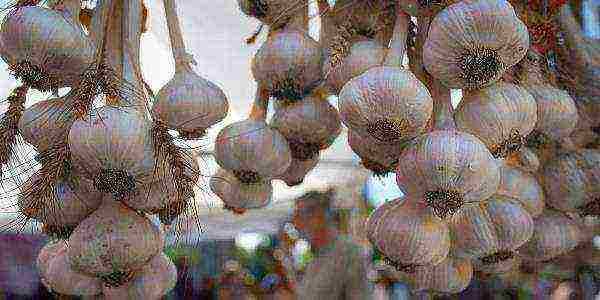
Landing dates
Planting dates depend on the variety:
- winter garlic is planted in late September – mid-October, so that it can take root before the onset of frost, but does not sprout to the surface. Only in this case will he be able to calmly endure the cold and give a large harvest;
- the summer variety begins to grow after the snow melts in early to mid-April. It tolerates cold and can germinate even at a soil temperature of 6 ° C. Good garlic can be obtained by planting early. It should be borne in mind that the head must be formed before the onset of hot weather, otherwise the bulbs of spring varieties will not be large.
Garlic needs to be planted and grown properly to produce large heads.
Growing large garlic in the garden
Garlic is a light-loving culture that does not tolerate wetlands... Without knowing how to grow it properly, it is difficult to achieve good results.
Several factors influencing the size of the future harvest:
- Choice of location: it should be open so that nothing obstructs the sun necessary for the sprouts.
- Bed dimensions: they should be wide enough (75 cm) for easier handling and high (8 cm) to prevent water accumulation.
- Planting scheme: make sufficiently wide aisles (20 cm) and a little less distance between the planted teeth in a row (10 cm), so that in the future it will be convenient to care for the crop. Densely distributing planting material - garlic - should not be, since the forced struggle for space and resources will not allow it to gain the necessary weight.
Garden bed preparation
One of the secrets of how to get a good harvest is preparing the beds for future plants. For winter crops, the site is carefully dug up 2-3 weeks before planting, so that the land has time to settle. If this is not done, then gradually, with the movement of the soil, the cloves of garlic will deepen. This will negatively affect the size of the harvest and the timing of its preservation.
For spring planting, the garden bed is also prepared in the fall, so that the introduced elements have time to transform into a form assimilable for sprouts. The earth is dug to the depth of a shovel, fertilized if necessary. It is important to loosen the soil well so that there is enough oxygen in it. After digging, the area is leveled and disinfected with a manganese solution. Then cover with foil and leave until planting.
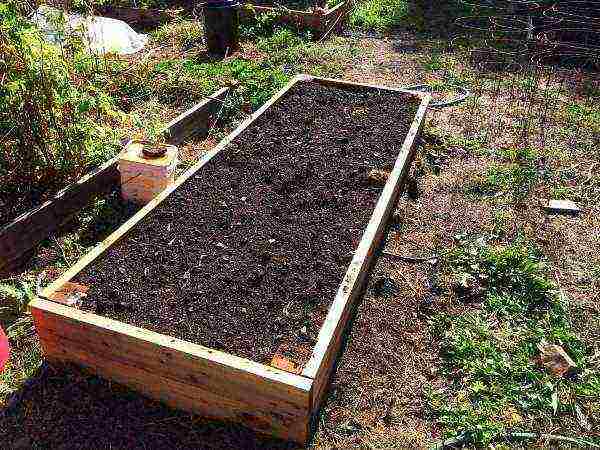
Fertilizing is necessary if the quality of the soil is not optimal for the crop. The soil should be:
- neutral;
- sandy loam;
- loose.
Reduce soil acidity by liming (a glass of lime per 1 m2). The structure is loosened with peat, sawdust and sand. They increase fertility by applying fertilizers: 5–6 kg of humus per 1 m2, for the same area - 1 liter of manure and ash. Organic matter is replaced with complex mineral fertilizers in the amount of 30–40 g per 1 m2.
It is important that the soil on the garlic bed is fertile, air and moisture permeable.
Preparation of planting material
The secrets of growing large garlic include preparing the heads for planting. There is a possibility to confuse the teeth of the winter variety with the spring ones. It is easy to distinguish them:
- the first are characterized by the presence of a central rod, around which an even number of lobules is distributed: 4, 6, 8;
- in the latter, the number of teeth can be different, often differ in shape, and there is no rod in the center.
To increase the immunity of future plants when preparing seed, the following points must be observed:
- Discard all damaged, rotten and moldy heads.
- Accreted, small teeth and their small number (2–3) indicate the degeneration of the variety and low yield. Therefore, for planting, it is better to take bulbs with large slices.
- Before planting, disinfect the heads by dipping them into a solution of copper sulfate (1%) or potassium permanganate (1%) for 20-30 minutes. For the same purpose, such a solution is used: 0.3 kg of wood ash is mixed with water (2 l), boiled, cooled, the light part is separated, into which the planting material is immersed for an hour.

Special requirements for the preparation of the spring variety:
- a month before planting, the heads are sent to a cool place (-3 - +2 ° C);
- in a day, the seed is taken out and disinfected;
- for 12 hours soaked in a growth stimulator (Potassium Humate or Epine).
To accelerate growth, spring varieties are germinated. To do this, the teeth are laid out in a moistened cloth bag, which is wrapped in polyethylene for two days.
How to plant garlic
In order for the garlic to grow large, certain rules are followed when planting it.
Features of spring planting:
- watered only dry land, planted in wet chives without watering;
- planting depth - 3 cm;
- mulch until sprouts appear with peat.

Planting rules in the fall:
- planting is done on time: the cloves should take root, but not germinate;
- so that the bulb does not rot, sand or ash is poured into the grooves, the beds are not spilled;
- planting garlic to a depth of 5 cm (the larger the clove, the deeper), to reduce the risk of freezing;
- after carrying out all the necessary measures, the soil is leveled and mulched with peat or rotted sawdust with a layer of at least 3 cm;
- in winter, the top is covered with foliage or spruce branches (until the snow falls), and during the thawing period, the shelter is dismantled.
Secrets of large garlic
Compliance with certain rules for growing a crop will help increase yields. Outdoor-grown garlic will be large if:
- land it on time;
- choose the right variety;
- it is imperative to update the planting material every 3 years, growing from bulbs;
- in shooting species, pinch off arrows in time;
- in spring varieties, tie leaves to stimulate the outflow of nutrients from the foliage to the head;
- take proper care of garlic (watering, fertilizing, mulching).
Compliance with crop rotation
As a recommendation for a gardener-gardener - observance of crop rotation:
- the best precursors for garlic in the country are siderates (alfalfa, clover, oats, mustard), strawberries, pumpkin, cucumbers, peas, zucchini, cabbage;
- it will not be possible to get a high yield after nightshade crops (tomatoes, potatoes, eggplants) and root crops (beets, radishes, onions, garlic): in this case, the likelihood of plant diseases increases, as well as a decrease in the size of the heads.
If you plant a crop next to tomatoes or peppers, then the yield will be larger.
You should not sow the garden for several years in a row with one crop, so as not to reduce the yield. Large garlic will turn out only with an annual change of the landing site.
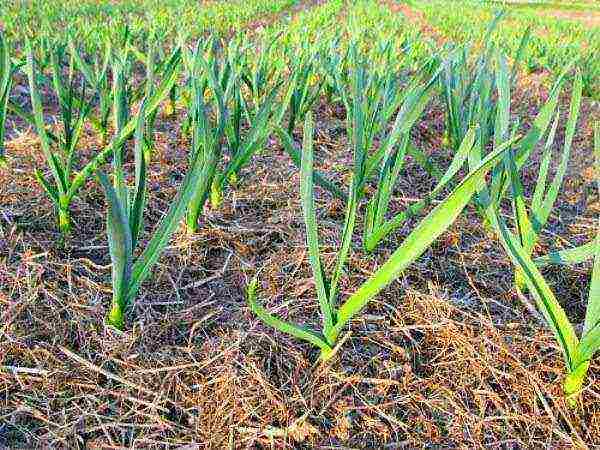
Garlic garden care
Caring for growing garlic after planting involves mulching the soil. It allows you to:
- keep moisture;
- reduce the amount of watering;
- exclude weeding, loosening.
After the arrows grow back up to 20 cm in length, they are shortened to 5 cm: you can cut off with a sharp tool or break off, leaving a stump of the desired length. The main thing is to remove the upper part - the rudiment of the future inflorescence. This will increase the supply of nutrients to the bulb.
20-30 days before harvesting (winter varieties - until mid-July, spring varieties - in the first week of August) shake off the soil from the heads. This is done to redirect some of the food to the bulb and thereby increase its size. The soil is removed with a special device so that the teeth half peep out of the soil.
Watering
Since garlic is a moisture-loving plant, it grows well in moist soil. Therefore, an important point in the care of the crop is the correct watering.
The basic rules are as follows:
- most of all, a vegetable needs moisture in the spring, when the root system is actively forming (the first 3 weeks after planting): during this period it needs to be watered abundantly (15 liters per 1 m2) every 5-7 days;
- the volume and frequency of watering depend on the weather: at a moderate temperature, 10–12 liters are consumed per 1 m2 with a break of 1–1.5 weeks, in the heat, 15 liters are poured onto the same area with an interval of 5–6 days, and on rainy days the soil is moistened stop;
- after the procedure, it is necessary to sprinkle the bare heads with earth;
- use preferably warm water, which has stood for some time in the sun.
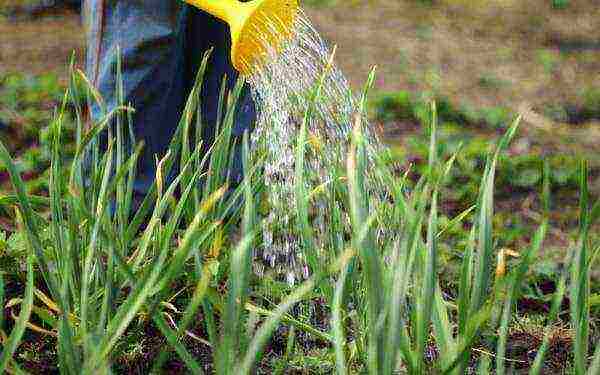
In no case should waterlogging be allowed, since fungal diseases develop in such an environment and the bulbs deteriorate.
Top dressing
If you feed the plants in time, then you can grow garlic with large heads. The winter variety is shed with urea in the spring after the snow melts, and then fertilized as needed. Poor soils are enriched with nutrients 1-2 times a month until the end of the growing season.
When growing spring garlic, top dressing is applied twice:
- The first feeding is done in early spring with a solution of bird droppings (1 kg per bucket of water) or mullein (in the same amount per 8 liters of water).
- In the middle of summer, pour it with an ash solution (a glass on a bucket of water).
The gardener should follow one important principle: the amount of fertilizer applied should be in moderation. Excess organic matter contributes to the yellowing of the foliage and the cessation of bulb growth. A large amount of minerals will negatively affect their taste and quality.
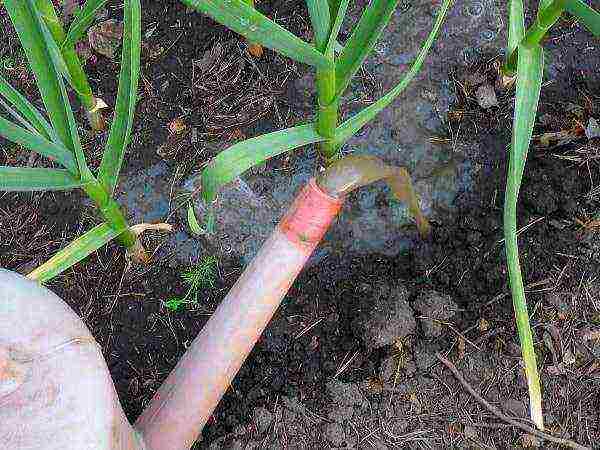
Diseases and pests
A number of pests and diseases can spoil the enjoyment of growing a crop. Garlic is attacked by nematodes, bears, centipedes, onion moths and other insects.
Traditional methods will help save plants from pests:
- spraying twice a month with infusion of tobacco (0.25 kg) and ground pepper (2 tsp): pour 3 liters of hot water, hold for three days, then strain, dilute with water to 10 liters, stir in liquid soap (2 tbsp. l.);
- pollination with a mixture of pepper, tobacco and wood ash 2 times a month.
The plant is susceptible to such diseases:
- rot of the bottom (the bulb rots, the roots die off, the foliage turns yellow);
- downy mildew (the process of maturation of the head stops);
- white rot (the aerial part of the plant dies off and the bulbs rot);
- bacterial rot (teeth deteriorate).
To prevent the development of diseases, before planting, the seed is treated with a solution of ash, copper sulfate or potassium permanganate.
Harvesting and storage
Winter varieties ripen in early August. When the lower leaves turn yellow, they start harvesting. You cannot tighten with this, otherwise the heads will begin to dry out and crumble. The shelf life of such a product may be reduced.
Spring varieties are harvested in late summer - early autumn, when the feathers turn yellow and begin to lay down, and the bulbs have already been formed.
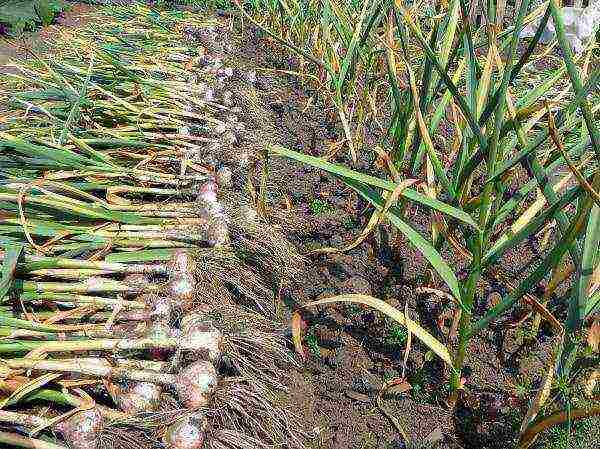
After harvesting, the plants are dried for 1.5 weeks, shaking off the ground. Further, the roots and part of the stem are cut, leaving a core 5 cm long for winter crops, 2 cm for spring crops. The largest specimens are selected for seed.
The storage conditions are as follows:
- temperature: 16–20 ° С for spring varieties, 2–4 ° С - for winter crops;
- humidity: medium.
Features of growing garlic from bulbs
Garlic is considered a perennial (three-year) crop, but is often used as an annual, due to which it gradually degenerates. To avoid this, the seed must be regularly renewed.
When planting winter bulbs, several arrows are left on the sprouts grown from large cloves. Seeds are formed on them - one-toothed. When it's time to harvest, the plant is tied into a bunch and hung to dry. During this period, plastic substances flow to the bulbs from the green mass of the plant, promoting growth. After the stem is completely dry, they are carefully separated.
Bulbs are planted both in spring and autumn in prepared soil.They are deepened by 3 cm, since they are very small. Dig when the leaves begin to turn yellow. Then they are dried: first for a couple of days in the sun, then under a canopy. One-teeth planted in the fall will yield a good harvest with proper care.
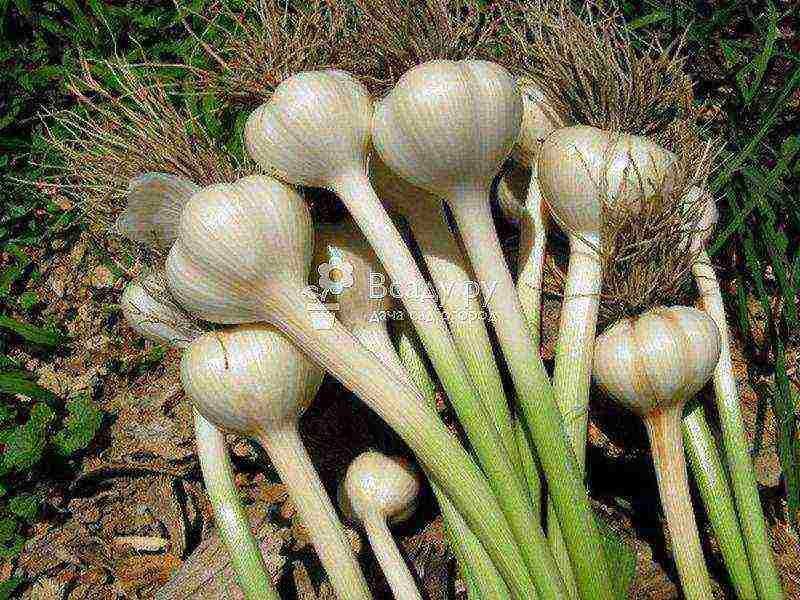 Growing the best harvest of garlic outdoors
Growing the best harvest of garlic outdoors
Before planting garlic, a growing method should be selected, which may depend on varietal characteristics or desired harvest time. In the future, garlic, cultivation and care in the open field for which it is correctly performed, will thank you with a generous and large harvest.
Winter and spring varieties of garlic
The varietal variety of garlic is quite large, since the varieties are divided into two groups, differing in the cultivation method and planting dates:
- Winter crops (shooting and non-shooting);
- Spring (non-shooting).
Winter varieties
They are characterized by larger heads and early ripening. Basically, the cultivation of winter garlic in the open field is carried out for consumption and use in cooking, since it is poorly stored.
Winter garlic variety - Lyubasha
Shooting varieties ripen faster than non-shooting varieties, but they require additional labor for breaking arrows. Among the most popular winter varieties are:
- Zubrenok is a fruitful shooting variety with large heads.
- Alcor is a common variety among gardeners. Medium bulbs. The scales of the teeth are pink-violet.
- Lyubasha is a shooting variety with high juicy tops and large flattened bulbs.
- Herman is the most stable of winter garlic varieties with multi-toothed, medium-sized heads.
- The doctor is a non-shooting variety of medium ripening periods. The heads include up to sixteen teeth, transportable.
Spring varieties
Spring garlic varieties do not produce arrows. The teeth of the head are formed in several rows, and the outer ones are always larger and are recommended for further planting. Spring garlic, planting and care in open ground, which differs from winter garlic, has smaller bulbs in comparison with them, but it is stored much longer (up to a new harvest).
Spring Garlic Victorio
- Moskovsky is a large-fruited variety with white heads.
- Gulliver - characterized by dense flattened white heads and keeping quality up to 8 months.
- Victorio is highly resistant to disease. The denticles are yellowish in color. The heads are round, medium in size.
Preparing the beds for planting garlic
The opinion that garlic will grow everywhere is wrong. Large yields are possible only if the area for growing winter garlic or spring varieties is chosen correctly.
Preparation and fertilization of ash soil for garlic from autumn
Soil selection
- Choose a flat, sunny area. Garlic planted in the lowlands will get wet and rot. Its keeping quality is sharply reduced. In the shade, the vegetable will develop poorly and grow bulbs.
- Fertile and moisture-consuming soil is suitable, garlic loves loams, and soils oversaturated with organic matter.
Crop rotation rules for garlic
- It is undesirable to grow garlic after onions, cucumbers, carrots, tomatoes. The most suitable for garlic will be the beds on which grew cabbage, potatoes, legumes, or green manure plants.
- Garlic is a welcome neighbor for strawberries, strawberries, raspberries, roses, gooseberries and currants. It will scare away pests (slugs, borers, caterpillars and moles) from these crops, while developing well and forming a good harvest.
It's important to know
You can grow garlic on one bed for no more than two years in a row. In the future, this area can be returned to garlic only after four years.
Preparing the beds for garlic
The beds should be prepared in advance, digging them up in the fall and mulching with weeds. In the spring, in advance (at least two weeks in advance), you need to dig up the garlic bed on the bayonet of a shovel and add humus (bucket / m²), superphosphate (30g / m²), potassium salt (20 g / m²).
- If the acidity of the soil is increased, lime, chalk or dolomite flour of your choice for deoxidation must be added;
- When the soil is washed out and depleted, you should regularly water the beds with an ash solution, as well as dust the beds before digging in the spring and sprinkle abundantly with ash during autumn preparation.
Methods and timing of planting garlic
Garlic is a seedless vegetable. It reproduces only vegetatively - by cloves or air bulbs formed on the arrows. Therefore, his landing and preparation for it are different.
Bulbs or bulbs (other names - garlic seeds, air seeds, air bulbs) are called organs of vegetative reproduction - small bulbs, which by definition are not seeds. But the air capsule (has the second name - the seed case) on the arrow of the garlic, in which they grow, is called the seed.
Teeth preparation
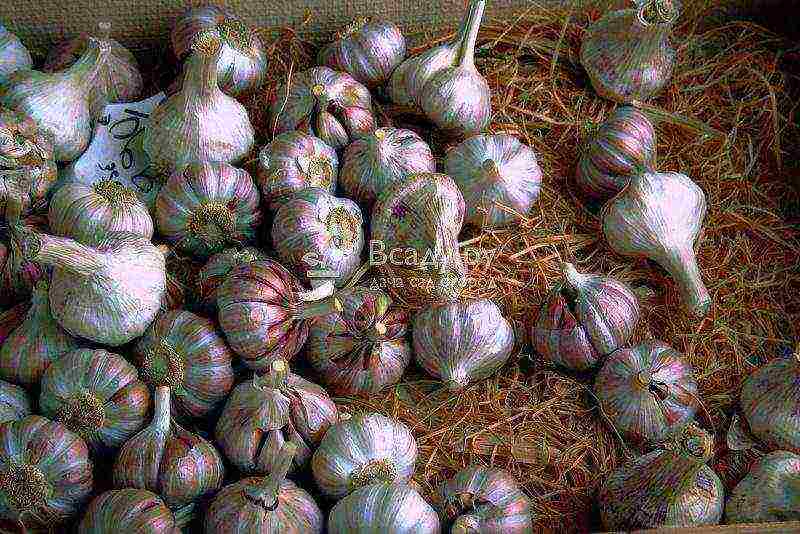 Preparing garlic for outdoor planting
Preparing garlic for outdoor planting
To ensure that the harvest does not disappoint you, the garlic cloves need to be properly prepared for planting.
- The heads are sorted, choosing the largest ones, and discarding the damaged ones. Even if one tooth with signs of infection is found in the head, the rest are also not suitable for planting.
- Treat the planting material with "Fitosporin" (soak the garlic for 5 minutes) to prevent fungal diseases. Soaking in a pink solution of potassium permanganate or 1% iodine is possible.
- Apply pre-sowing fertilization by dipping the teeth into the ash slurry (pour 0.5 liters of ash into 1 liter of water and boil for 30 minutes). In the future, caring for winter garlic prepared in this way will be easier.
It is necessary to divide the heads of garlic into teeth just before planting. Otherwise, the bottom of the bulbs will dry out and the root system will not develop. It is better to remove the upper husk, since it is in it that pathogens and infections accumulate.
Gardener advice
For planting before winter, the garlic cloves must be well dried. Otherwise, it will start to germinate prematurely and will be damaged by frost.
Planting winter garlic
Winter garlic is planted in the fall, 25-30 days before the onset of stable cold weather. Usually this period falls on the end of September - mid-October. During this time, the teeth will root well, but will not have time to start growing.
- With an earlier fall planting, garlic will begin to grow, which is fraught with frost damage to the tops and a decrease in yield.
- If it is late, the teeth will not take root until the onset of cold weather and will freeze in winter.
Planting winter garlic outdoors
Garlic is planted in open ground in rows according to the scheme: row spacing - 20-25 cm, distance in a row - 8-10 cm.The teeth are stuck into the prepared grooves with the bottom down to a depth of about 5 cm.
The bottom of the groove should be loose so that the roots can penetrate deeply without hindrance. On light sandy and sandy loam soils, it is possible to plant garlic to a depth of 12 cm. There is no need to water the plantings.
When all the tines are planted, the bed is leveled with a rake and mulched with peat. Branches or spruce branches are laid on top. They will keep snow and winter garlic, planting and caring for which were initially carried out according to all the rules, will successfully overwinter.
How to plant winter garlic: growing and care, video
Landing air bulbs
The balloon planting method is used for a two-year crop cycle. This planting of winter garlic has several advantages:
- Healthy planting material. They do not come into contact with the ground, so they are not susceptible to infection by harmful bacteria.
- Saving. The best and most significant part of the garlic harvest is allocated for planting with tines.
Garlic boxes with air bulbs for planting
The air bulbs are planted in the same way as the prongs of winter garlic. In the first year, heads will grow from them into one clove for further planting, in the second - full-fledged bulbs.
Planting "air seeds" and growing garlic in the open field video
Planting spring garlic
Spring garlic is planted in the beds in early spring (early April), as soon as the snow melts, so the preparation of the site should be taken care of in the fall. It is not worth waiting for the soil to mature for comfortable work. The earlier the garlic is planted, the greater the harvest will be.
It is advisable to arrange the rows in the south-north direction so that the plants are evenly illuminated. In this case, the planting of garlic in the spring is carried out according to the same scheme as for the winter one (8-10 cm in a row, row spacing 20-25 cm).
Growing and caring for garlic outdoors
In the spring, garlic is one of the first in the garden to grow. In order for the harvest of garlic to be generous, planting must be given due attention. The care of garlic in the open field is reduced to timely feeding and regular watering.
Growing garlic outdoors
Garlic care in spring
When the first 2-3 leaves of garlic appear, the soil in the aisles must be loosened, and then mulched with peat or humus. Watering the plants begins as soon as the earth dries up. In this case, watering should be abundant (10 l / m²) and regular (once a week).
Lack of moisture negatively affects the harvest - the bulbs become smaller or do not form at all. After each watering, it is imperative to loosen the soil in the garden bed.
Rules for watering garlic in spring
In the spring, the following fertilizers are applied:
- In the phase of 3-4 leaves - urea solution (1 tablespoon per 10 liters of water). Fertilizer is poured over garlic from a watering can (by sprinkling);
- Two weeks later, a solution of nitrophoska or nitroammofoska (2 tablespoons per 10 liters of water) is added under the garlic.
When applying dressings in the spring, you need to remember that nitrogen-containing fertilizers are needed for garlic only in the initial phase of growth. Later, phosphorus-potassium supplements are needed. Lack of nutrients can cause premature yellowing of garlic leaves.
Important!
For garlic, which is properly cared for, fresh manure, as well as a large amount of other nitrogen fertilizers, must not be applied. This will cause violent growth of the green mass at the expense of bulb formation.
Summer care
In summer, watering of garlic is gradually reduced, and completely stopped at the end of June (2-3 weeks before harvest). Garlic care in June includes the last dressing. To do this, dilute 2 tbsp in 10 liters of water. superphosphate and water the garden with this solution.
Winter garlic with arrows
Taking care of garlic in July is necessary, when the arrows of winter garlic reach a height of 10 cm, they are broken out. So the plant will not expend energy on ripening "babies" and the bulbs will be larger.
For the propagation of garlic with air bulbs, it is enough to leave arrows on several plants. The rest of the technology for growing winter garlic and spring garlic is the same.
Protecting garlic from diseases and pests
Garlic is often exposed to fungal diseases, such as:
- fusarium;
- bacterial rot;
- white rot;
- black mold.
It is quite difficult to deal with them and spraying with fungicides (Bordeaux liquid, Fitosporin, etc.) does not always give the desired result. It is easier and more effective to prevent the development of these diseases by etching the teeth before planting and observing crop rotation.
Garlic yellowing problem
No less harm is caused by pests that complicate both the cultivation of winter garlic and spring garlic. The most dangerous of them are:
- stem nematode;
- onion fly.
To combat the nematode, preventive measures are used. Deep digging of the site, destruction of plant debris, planting chicory and calendula on the site will help.
To combat onion flies, root and garlic mites, as well as onion hoverflies, special solutions are used.
Onion fly remedy recipe
Pour a glass of tobacco dust and a few teaspoons of ground pepper with 2-3 liters of boiling water and insist warm for 3 days. Strain the infusion and dilute with water to 10 liters, then sprinkle with garlic.Such spraying should be carried out every 10-14 days.
Cleaning garlic from the beds
The harvest time is different for different varieties of garlic. Basically, harvesting begins in July, but it is better to determine readiness more accurately by yellowed lower leaves and by ripe and opened air capsules with bulbs. It is not worth pulling with the harvesting of garlic until the foliage dies completely. In this case, the heads will disintegrate and poorly stored.
Harvesting outdoor garlic
Advice from the gardener
Dig up garlic only in dry weather. Extracted from moist soil, it will not be stored and will rot quickly. When harvesting, you need to try to damage the roots as little as possible.
Cleaning garlic from the beds
Outcome
With proper preparation of the beds and adherence to planting technology, growing garlic in the open field will only bring pleasure, the plant will be healthy, and the harvest will delight you with an abundance. To preserve the garlic for the winter, the dug out bulbs are hung or laid out to dry in a dry, shaded place. The roots are cut from completely dry bulbs and stored as such.
Garlic is one of the most common crops that can be found in every garden plot in any region of the country. Such plants bear spicy fruits with a pungent taste, besides, garlic is very easy to grow and it is not afraid of cold, return frosts and other weather factors.
You can grow a vegetable in a garden or dacha, or sow at home, for example, in a pot at home, on a balcony or in an apartment on a windowsill in winter.
Basic requirements for growing garlic in the country or in an apartment on a home windowsill
Growing garlic is a fairly simple process that even a novice gardener can do. The main thing is to adhere to all the rules and perform the necessary actions on time: take care of it properly, although if you grow it correctly, it can take a lot of trouble.
Having decided to grow a vegetable on your site, you first need to choose a suitable type, because planting and growing winter and spring crops are different from each other.
Varieties belonging to different species differ from each other in terms of planting, the layout on the garden bed and the rules of care, so if you equalize them and do not take into account important details, you can forget about a somewhat rich harvest of spicy heads.
Also, before planting it on your site, you should think about a suitable place that will meet all the requirements. The soil must be light, nutritious and have neutral acidity. It can take a lot of time to achieve all these indicators on the wrong ground.
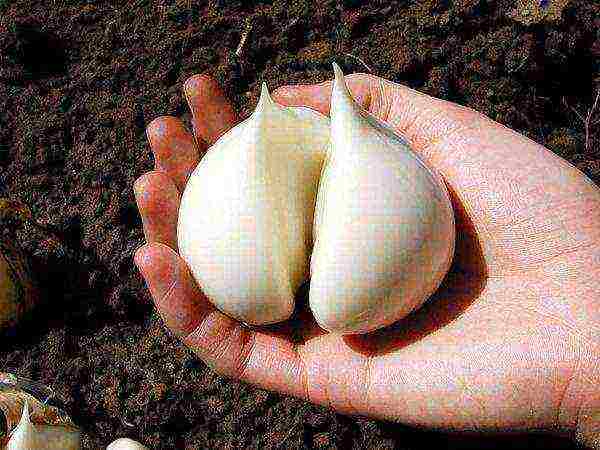 Before starting to grow garlic, you need to decide on its variety.
Before starting to grow garlic, you need to decide on its variety.
When to plant winter and spring garlic in the garden - the right conditions
Planting dates depend not only on the preferences of the gardener and on the climatic conditions of the region, but also on the species that is planned to be grown.
Spring garlic is planted in early spring, once after the snow melts, but no later than April 10... This species has small heads with chaotically spaced teeth. The disadvantage of such fruits will be their less intense and pungent taste; the advantage is considered to be a long shelf life and the possibility of using it within 12 months.
Winter crops are planted before winter, that is, during the time period from mid-September to mid-October... It is very important to take into account the fact that before the onset of the first frost, the teeth must have time to build up a powerful root system, on average, this process lasts 3-4 weeks.
The winter crop boasts large heads, with even and sharp teeth. The main disadvantage of the species will be a shelf life of 3-4 months.
Landing dates play a huge role.
In spring, plants are planted as early as possible so that they have time to ripen before the onset of cold weather.An early fall planting can also ruin the entire crop, because if the frost comes too late, the garlic will start to grow, after which it will die.
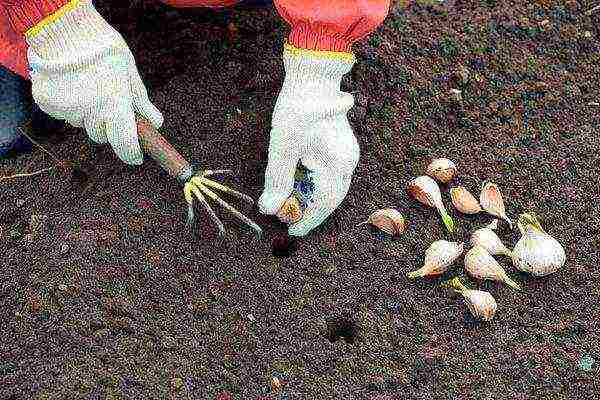 The timing of planting garlic plays a very important role.
The timing of planting garlic plays a very important role.
Preparing the soil before growing and sowing
It's a non-harmful culture, but finding the right place you can significantly increase the amount of the harvested crop. The plant prefers fertile soil with neutral acidity. Also, the soil should be light and breathable. Loam is best suited for such purposes.
The place must meet the following criteria:
- plenty of sunlightrequired for fruit ripening;
- melt water and precipitation should not accumulate on the site. A deep location of groundwater is also desirable;
- Peas, cabbage, squash, pumpkin, or greens are considered the best crop precursors. It is not recommended to plant it in those places where cucumbers, tomatoes, onions, carrots and garlic itself grew before it.
If clay or sandy soil predominates on the site, then they are diluted with peat, while the peat soil is mixed with sand or clay.
 If the soil is clayey, it is diluted with peat.
If the soil is clayey, it is diluted with peat.
Regardless of the timing of planting, the land must be prepared in the beginning of September... To do this, it is dug up, weeded, cleaned of stones and debris, after which the following fertilizers are applied to each square meter:
- 1 bucket of humus or rotted manure;
- 30 grams of superphosphate;
- 20 grams of potassium salt.
Preparation of planting material
Before planting garlic in open ground, planting material must be sort, choosing from the total mass of damaged, diseased, soft, curved, too small and uncoated teeth. They are not suitable for planting and are unlikely to be able to give a decent harvest.
Preparation of cloves for planting is as follows:
- for stratification, the planting material is placed in a refrigerator for 15-20 days;
- then the teeth are disinfected, keeping for 2 hours in a solution of wood ash, potassium permanganate or copper sulfate;
- so that the teeth germinate as soon as possible, they are treated with a growth stimulant or wrapped in a damp cloth, put in a plastic bag and kept in this state for 2-3 days.
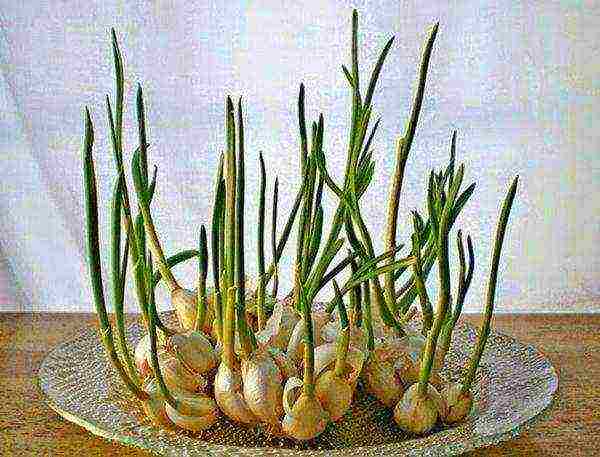 To make the chives germinate faster, they are treated with a rooting stimulant.
To make the chives germinate faster, they are treated with a rooting stimulant.
Planting process
Landing is carried out according to a certain scheme:
- Initially, furrows are made in the garden, at a distance 20-25 centimeters apart;
- When planting spring garlic, the depth of the furrows should be 7-9 centimeters, and when using winter varieties, 15-20 centimeters;
- The distance between individual plants will depend on the size of the planting material. Usually, spring varieties are planted from a distance 6-8 centimeters from each other, and winter varieties at a distance 12-15 centimeters.
The teeth are buried strictly vertically. In the event that the rib is located to the south, then the garlic feathers will grow more green and saturated. If the soil is dry, it must be watered immediately after planting.
In spring, mulching of plantings with peat or sawdust should be done at the request of the gardener, while during autumn planting, these works must be performed in order for the garlic to survive the frosts in snowless winters.
Care for good and large heads and feathers
Care is extremely simple and consists of several usual operations, which include watering, weeding, loosening and feeding the plants.
Water the vegetable in such a way that the soil always stayed wet... In dry weather, such work is performed 2-3 times a week, while on rainy days, watering can be completely abandoned. It is worth remembering that in August, soil moistening must be stopped. At this time, the bulb begins to gain weight and volume and does not need watering.
All dressing of garlic is carried out in conjunction with watering, this is necessary for the best assimilation of fertilizers. Winter and spring garlic are fertilized according to different schemes.
| Spring garlic | Winter garlic | |
| 1 top dressing | As soon as the plant releases the first leaves, it is fertilized with nitrogen fertilizers (urea, mullein solution or bird droppings) | In early spring, about 7-10 days after the snow melts, 1 square meter of soil is added: 100 grams of superphosphate, 50 grams of potassium sulfate and 50 grams of ammonium nitrate. |
| 2 feeding | 2 weeks after the first feeding, complex mineral fertilizers are applied | After 25-30 days, using the same composition. |
| 3 feeding | In late June-early July, phosphorus-potassium fertilizers are applied | The last feeding is applied in mid-July, when the head begins to grow. |
To obtain larger heads of garlic, you need to remove the arrows every time they reach a size of 15 centimeters.
Winter garlic needs periodic renewal. To do this, once every 3-4 years, instead of cloves, bulbs are planted, which by the end of the season will bear single-tooth fruits, which are planting material for the future harvest.
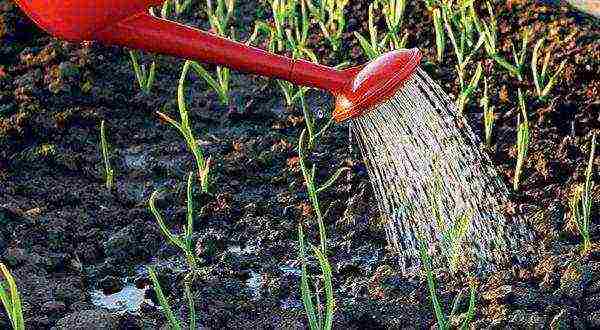 It is very important that the soil remains moist at all times.
It is very important that the soil remains moist at all times.
Diseases and pests
Garlic is often affected by diseases and pests. Of all the existing diseases on such a culture, the most common are:
- white, gray and neck rot;
- helminthosporiosis;
- fusarium;
- smut;
- downy mildew;
- mosaic;
- rust, etc.
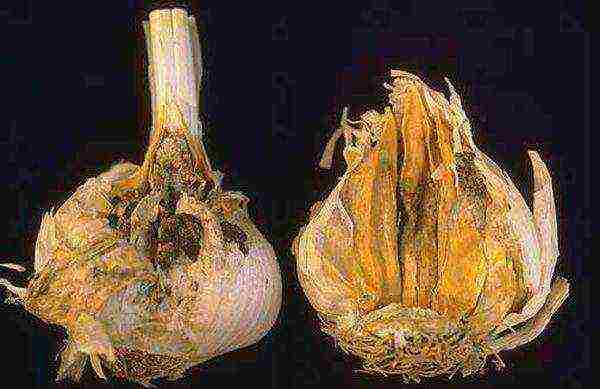 Garlic neck rot
Garlic neck rot
Insects most commonly found on garlic:
- onion lurker;
- tobacco thrips;
- nematode;
- caterpillars;
- onion flies;
- bear;
- onion moth;
- centipede.
 Nematode defeat
Nematode defeat
Unfortunately, many diseases destroy plants, so it is impossible to get rid of them, the only way out is removal of affected garlic and prophylactic treatment of healthy individuals with fungicides or folk remedies, which include ash infusion.
You can get rid of insects with the help of insecticides, mechanical methods, which include manual assembly, and various folk tricks.
In order to prevent the appearance of such troubles, it is necessary to follow the rules for planting plants, to prevent unwanted neighborhoods and predecessors. It is also very important to pre-disinfect the planting material.
Harvesting and storage
After a rich harvest of garlic is obtained, it must be kept safe as long as possible. Collecting the fruits of winter garlic is carried out late July-early August, and spring a month later.
You can see the maturity of garlic by the following signs:
- new feathers stopped forming, and old ones turned yellow and lay on the ground;
- the visible head has acquired the correct color and size.
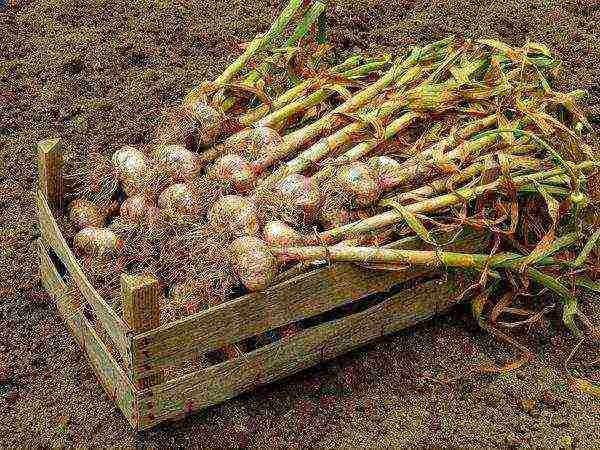 Ripe garlic after harvest
Ripe garlic after harvest
After harvesting, it is prepared for storage by doing the following:
- The heads are shaken off the ground and dried for 10 days at a temperature 25 degrees outdoors or in a well-ventilated area;
- The roots and leaves are completely removed, the neck is trimmed up to 2-5 centimeters;
- At the last stage, the heads are folded into boxes with holes, nets or braided into pigtails.
Winter garlic is stored worse than spring garlic. Autumn heads are stored at a temperature of 2-4 degrees, and spring ones 16-20 degrees. Indoor humidity should be between 60-80 percent.
Growing garlic on your own plot is a very interesting activity, during which you can learn useful skills regarding the correct planting and care of plants. If you follow all the recommendations, then a rich harvest will delight every gardener from year to year.
